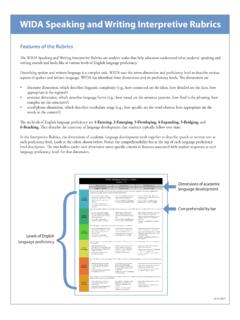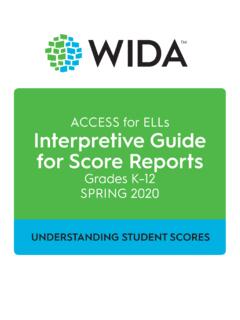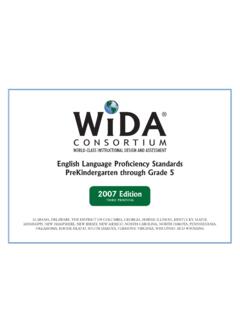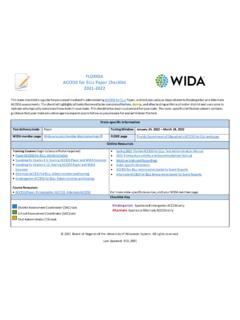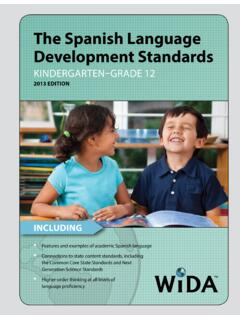Transcription of Can Do Descriptors - WIDA
1 Can Do Descriptors KEY USES EDITIONG rade 1 The WIDA Can Do Descriptors , Key Uses Edition, Grades K 12 The WIDA Can Do Descriptors provide examples of what language learners can do at various stages of English language development in listening, speaking, reading and writing. The WIDA Can Do Descriptors , Key Uses Edition is one component of the WIDA Standards Framework (shown at right). The framework, as a whole, supports the implementation of the WIDA English Language Development Standards in the instruction and assessment of language learners. We encourage educators to use the WIDA Can Do Descriptors , Key Uses Edition in conjunction with the other components of the framework, along with the previous edition of the Can Do Descriptors .
2 For more information on the WIDA Standards Framework, visit The WIDA Can Do Descriptors , Key Uses Edition provides examples of academic language use for four specific communicative purposes. These purposes, referred to as Key Uses, were identified based on reviews of literature and a language analysis of college and career readiness standards: Recount: To display knowledge or narrate experiences or events. Example tasks for the Key Use of Recount include telling or summarizing stories, producing information reports, and sharing past experiences. Explain: To clarify the why or the how of ideas, actions, or phenomena. Example tasks for the Key Use of Explain include describing life cycles, sharing why or how things work, stating causes and effects, and sharing results of : To persuade by making claims supported by evidence.
3 Example tasks for the Key Use of Argue include stating preferences or opinions and constructing arguments with : To interact with others to build meaning and share knowledge. Example tasks for the Key Use of Discuss include participating in small or large group activities and WIDA Can Do Descriptors , Key Uses Edition and the example Descriptors are not exhaustive but are meant to help guide the planning and conversation around meaningful participation of language learners in stardards-based contest curriculum, instruction, and assessment. 2 Exemplifying the WIDA Can Do PhilosophyPerformanceDe nitionsStandards & their MatricesGuiding Principles of Language DevelopmentDevelopmentally-Appropriate Academic Languagein Sociocultural ContextsWIDA Standards FrameworkOrganization of the WIDA Can Do Descriptors , Key Uses Edition, Grades K 12 The WIDA Can Do Descriptors , Key Uses Edition is organized by grade-level bands (K, 1, 2 3, 4 5, 6 8, and 9 12) that correspond to those in ACCESS for ELLs Within each grade-level band , the Descriptors are organized by Key Use (Recount, Explain, Argue and Discuss)
4 And within each Key Use, there are example Descriptors for WIDA s six levels of language proficiency (ELP Levels 1 6). The Descriptors in Level 6 represent the language performance of students who have met all the criteria for Level 5. Unlike the Descriptors at Levels 1 5 that provide examples of performance at the end of the level, the Descriptors at Level 6 are examples of performance within Level 6. For three of the Key Uses (Recount, Explain, and Argue) you ll see Descriptors for the four language domains (Listening, Reading, Speaking, and Writing). The Descriptors for the Key Use Discuss are only shown for oral language. The Key Use Discuss highlights the importance of oral language development for meaningful participation of all language learners, regardless of their level of language proficiency.
5 Potential Uses for the WIDA Can Do Descriptors , Key Uses Edition AudiencesThe WIDA Can Do Descriptors , Key Uses Edition can who work with language learners, including coaches, teachers ( , general education, gifted and talented, special education, Title I), language specialists, and support staff. Differentiate curriculum, instruction, and assessments designed in English based on language learners levels of English language proficiency Collaborate and engage in instructional conversations about the academic success of language learners in English environments Advocate for equitable access to content for language learners based on their level of language proficiencyAdministrators and school leaders Communicate with other educators about students English language development Support the WIDA Can Do Philosophy throughout schools and districts Advocate for equitable access to content for language learners based on their level of language proficiencyStakeholders are encouraged to use
6 The Can Do Descriptors beyond the audiences and purposes identified above to advocate on behalf of language Level 1 EnteringELP Level 2 EmergingELP Level 3 DevelopingELP Level 4 ExpandingELP Level 5 BridgingELP Level 6 ReachingLISTENINGP rocess recounts by Mimicking gestures or movement associated with oral commands Matching key words or expressions in songs, chants, and poems to illustrationsProcess recounts by Acting out oral statements using manipulatives or real-life objects Pointing to objects, characters or places from oral descriptionsProcess recounts by Sequencing pictures of stories read aloud ( , beginning, middle, end) Following modeled oral instructions related to content Process recounts by Identifying characters, plots, and settings from oral stories Finding details in illustrated narrative or informational text read aloudProcess recounts by Constructing models based on instructions from extended oral discourse with a partner Following multi-step oral directions during content-related activitiesProcess recounts by Matching relevant details to main ideas presented in oral discourse Identifying different genres through multiple readings of text by adults ( , rhymes, stories, informational text)
7 SPEAKINGR ecount by Repeating words, phrases and memorized chunks of language related to different topics Answering yes or no questions about stories or experiencesRecount by Stating content-related facts in context ( , playing telephone) Describing characters or places in picture booksRecount by Retelling simple stories from picture cues Participating in dialog with peers on familiar topicsRecount by Restating information with some details Summarizing a series of familiar events or routinesRecount by Presenting information on content-related topics Sharing details about personal experiences with peers and adultsRecount by Producing discourse appropriate to task and situation Rehearsing content-related presentations with peersKEY USE OF RECOUNTBy the end of each of the given levels of English language proficiency* English language learners *Except for Level
8 6, for which there is no Level 1 EnteringELP Level 2 EmergingELP Level 3 DevelopingELP Level 4 ExpandingELP Level 5 BridgingELP Level 6 ReachingREADINGP rocess recounts by Using pictures and illustrations to identify themes or storylines Matching vocabulary to illustrated storiesProcess recounts by Pointing to icons, letters, or illustrated words that represent ideas Identifying repetitive words and phrases in textsProcess recounts by Identifying Wh-words in questions ( , who, what, when) Recalling content-related information from illustrated texts read aloud Process recounts by Identifying the main topic of texts Ordering illustrations based on sequence of events from texts read aloudProcess recounts by Distinguishing among characters, settings.
9 And events in narratives Reconstructing texts read orally using drawings or re-enacting text with performances Process recounts by Identifying who is telling the story at various points in texts Matching original text to paraphrased versionsWRITINGR ecount by Forming words using a variety of strategies Answering Wh- oral questions or using icons to plan storiesRecount by Providing information in graphic organizers Presenting content-related information labeling visuals or graphicsRecount by Describing feelings or reactions to personal events or situations Recalling information from events or experiences Recount by Producing a series of related sentences from transition word starters ( , first, next, last)
10 Describing observations first-hand or from media Recount by Composing stories or narratives using sequential language Editing personal narratives based on criteria for successRecount by Producing narratives with at least two sequential events Producing narrative sequences from timelines and labeled drawingsKEY USE OF RECOUNTBy the end of each of the given levels of English language proficiency* English language learners *Except for Level 6, for which there is no Level 1 EnteringELP Level 2 EmergingELP Level 3 DevelopingELP Level 4 ExpandingELP Level 5 BridgingELP Level 6 ReachingLISTENINGP rocess explanations by Identifying real-life objects based on descriptive oral phrases or short sentences Pointing to objects or people reflective of content-related vocabulary ( , family members)


